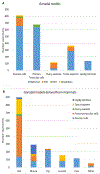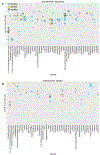Identification of candidate reference chemicals for in vitro steroidogenesis assays
- PMID: 29146384
- PMCID: PMC7008464
- DOI: 10.1016/j.tiv.2017.11.003
Identification of candidate reference chemicals for in vitro steroidogenesis assays
Abstract
The Endocrine Disruptor Screening Program (EDSP) is transitioning from traditional testing methods to integrating ToxCast/Tox21 in vitro high-throughput screening assays for identifying chemicals with endocrine bioactivity. The ToxCast high-throughput H295R steroidogenesis assay may potentially replace the low-throughput assays currently used in the EDSP Tier 1 battery to detect chemicals that alter the synthesis of androgens and estrogens. Herein, we describe an approach for identifying in vitro candidate reference chemicals that affect the production of androgens and estrogens in models of steroidogenesis. Candidate reference chemicals were identified from a review of H295R and gonad-derived in vitro assays used in methods validation and published in the scientific literature. A total of 29 chemicals affecting androgen and estrogen levels satisfied all criteria for positive reference chemicals, while an additional set of 21 and 15 chemicals partially fulfilled criteria for positive reference chemicals for androgens and estrogens, respectively. The identified chemicals included pesticides, pharmaceuticals, industrial and naturally-occurring chemicals with the capability to increase or decrease the levels of the sex hormones in vitro. Additionally, 14 and 15 compounds were identified as potential negative reference chemicals for effects on androgens and estrogens, respectively. These candidate reference chemicals will be informative for performance-based validation of in vitro steroidogenesis models.
Keywords: Androgens; Estrogens; Gonadal models; H295R; Sex hormones; Steroidogenesis.
Copyright © 2017. Published by Elsevier Ltd.
Figures






Similar articles
-
High-Throughput H295R Steroidogenesis Assay: Utility as an Alternative and a Statistical Approach to Characterize Effects on Steroidogenesis.Toxicol Sci. 2018 Apr 1;162(2):509-534. doi: 10.1093/toxsci/kfx274. Toxicol Sci. 2018. PMID: 29216406 Free PMC article.
-
Comparison of fathead minnow ovary explant and H295R cell-based steroidogenesis assays for identifying endocrine-active chemicals.Ecotoxicol Environ Saf. 2007 Sep;68(1):20-32. doi: 10.1016/j.ecoenv.2007.03.001. Epub 2007 Apr 20. Ecotoxicol Environ Saf. 2007. PMID: 17449096
-
The OECD validation program of the H295R steroidogenesis assay: Phase 3. Final inter-laboratory validation study.Environ Sci Pollut Res Int. 2011 Mar;18(3):503-15. doi: 10.1007/s11356-010-0396-x. Epub 2010 Oct 3. Environ Sci Pollut Res Int. 2011. PMID: 20890769
-
A predictive data-driven framework for endocrine prioritization: a triazole fungicide case study.Crit Rev Toxicol. 2016 Oct;46(9):785-833. doi: 10.1080/10408444.2016.1193722. Epub 2016 Jun 27. Crit Rev Toxicol. 2016. PMID: 27347635 Free PMC article. Review.
-
Assessing utility of thyroid in vitro screening assays through comparisons to observed impacts in vivo.Regul Toxicol Pharmacol. 2023 Oct;144:105491. doi: 10.1016/j.yrtph.2023.105491. Epub 2023 Sep 4. Regul Toxicol Pharmacol. 2023. PMID: 37666444 Free PMC article. Review.
Cited by
-
Safeguarding Female Reproductive Health against Endocrine Disrupting Chemicals-The FREIA Project.Int J Mol Sci. 2020 May 1;21(9):3215. doi: 10.3390/ijms21093215. Int J Mol Sci. 2020. PMID: 32370092 Free PMC article. Review.
-
Development of a prioritization method for chemical-mediated effects on steroidogenesis using an integrated statistical analysis of high-throughput H295R data.Regul Toxicol Pharmacol. 2019 Dec;109:104510. doi: 10.1016/j.yrtph.2019.104510. Epub 2019 Oct 29. Regul Toxicol Pharmacol. 2019. PMID: 31676319 Free PMC article.
-
Evidence for Cross Species Extrapolation of Mammalian-Based High-Throughput Screening Assay Results.Environ Sci Technol. 2018 Dec 4;52(23):13960-13971. doi: 10.1021/acs.est.8b04587. Epub 2018 Nov 13. Environ Sci Technol. 2018. PMID: 30351027 Free PMC article.
-
An integrated chemical environment with tools for chemical safety testing.Toxicol In Vitro. 2020 Sep;67:104916. doi: 10.1016/j.tiv.2020.104916. Epub 2020 Jun 14. Toxicol In Vitro. 2020. PMID: 32553663 Free PMC article.
-
Cheminformatics analysis of chemicals that increase estrogen and progesterone synthesis for a breast cancer hazard assessment.Sci Rep. 2022 Nov 30;12(1):20647. doi: 10.1038/s41598-022-24889-w. Sci Rep. 2022. PMID: 36450809 Free PMC article.
References
-
- Adashi EY, Hsueh AJ, 1982. Estrogens augment the stimulation of ovarian aromatase activity by follicle-stimulating hormone in cultured rat granulosa cells. J Biol Chem 257, 6077–6083. - PubMed
-
- Akingbemi BT, Ge R, Rosenfeld CS, Newton LG, Hardy DO, Catterall JF, Lubahn DB, Korach KS, Hardy MP, 2003. Estrogen receptor-alpha gene deficiency enhances androgen biosynthesis in the mouse Leydig cell. Endocrinology 144, 84–93. - PubMed
-
- Albert O, Desdoits-Lethimonier C, Lesne L, Legrand A, Guille F, Bensalah K, Dejucq-Rainsford N, Jegou B, 2013. Paracetamol, aspirin and indomethacin display endocrine disrupting properties in the adult human testis in vitro. Hum Reprod 28, 1890–1898. - PubMed
-
- Amiri BM, Maebayashi M, Adachi S, Moberg GP, Doroshov SI, Yamauchi K, 1999. In vitro steroidogenesis by testicular fragments and ovarian follicles in a hybrid sturgeon, Bester. Fish Physiology and Biochemistry 21, 1–14.
Publication types
MeSH terms
Substances
Grants and funding
LinkOut - more resources
Full Text Sources
Other Literature Sources
Medical

